Asaf Jahi dynasty
| Asaf Jah | |
|---|---|
 Coat of Arms of the Nizam | |
| Founded | 31 July 1734 |
| Founder | Asaf Jah I |
| Final ruler | Osman Ali Khan |
| Titles | Nizam-ul-Mulk Nawab |
| Style(s) | His Exalted Highness |
| Estate(s) | Kingdom of Hyderabad |
| Deposition | 17 September 1948 |
The Asaf Jahi was a dynasty which ruled the Kingdom of Hyderabad. The family came to India in the late 17th century, and became employees of the Mughal Empire. As the Mughals, of Turco-Mongol origin, were great patrons of Persian culture, language, and literature, the family found a ready patronage.
The dynasty was founded by Mir Qamar-ud-Din Siddiqi, a Viceroy of the Deccan—(administrator of six Mughal governorates) under the Mughal emperors from 1713 to 1721. He intermittently ruled after Aurangzeb's death in 1707 and under the title Asaf Jah in 1724. The Mughal Empire crumbled and the Viceroy of the Deccan, Asaf Jah I, declared himself independent, whose domain extend from the Narmada river in the North to Trichinopoly in the South and Masulipatnam in the east to Bijapur in the west.[1]
History[]
This section does not cite any sources. (February 2016) |
Nawab Khwaja Abid Siddiqi, grandfather of the first Nizam, was born in Aliabad near Samarkhand in the kingdom of Bukhara in modern-day Uzbekistan. His father, Alam Shaik, was a well-known Sufi and celebrated man of letters. Khwaja Abid's mother was of the family of Mir Hamdan, a distinguished Syed of Samarkhand.
Khwaja Abid, who had held the high office of Qazi (judge) and Shaik-ul-Islam, first visited India during the reign of Mughal Emperor Shah Jehan in 1655 on his way to Mecca. He presented himself at the Imperial Court where he won favours and robe of honour. He was offered a position in the Emperor's service, which he agreed to accept after his return from Mecca.
In 1657 Khaja Abid returned from his pilgrimage and joined the service of Aurangzeb. At that time Aurangzeb was in the Deccan preparing for the war of succession to the Mughal throne. Khaja Abid, besides being a learned man, was well versed in the art of war. Aurangzeb gave him an important post in the Imperial army. He was granted a high rank of 3000 Zat and 500 Sawars and the title of Khan.
After succeeding in the war of succession, Aurangzeb made him the Governor of Ajmer and subsequently of Multan with the title of Qalich Khan. He served the Emperor with distinction particularly during the early years of Aurangzeb's reign while he was consolidating and restoring peace in his newly acquired territory.
On 30 January 1687 during the siege of Golconda while leading the Imperial armies against the Qutb Shahi King, Qalich Khan died when he was struck fatally by a cannonball.
Qalich Khan was survived by five sons, and his eldest son Shahabuddin Khan, entitled Ghaziuddin Khan Feroz Jung, earned the position of highest distinction in the Mughal Court. He married Safia Khanum, daughter of Saadullah Khan, the famous Prime Minister of Shah Jehan, and by her had a son named Qamaruddin, who later became the celebrated Nizam-ul-Mulk, the founder of the Asaf Jahi Dynasty.
Asaf Jah I[]
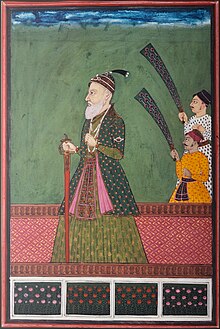
The founder of this dynasty was Mir Qamaruddin Khan, a noble and a courtier of the Mughal Muhammad Shah, who negotiated for a peace treaty with Nadirshah, the Iranian invader; got disgusted with the intrigues that prevailed in Delhi. He was on his way back to the Deccan, where, earlier he was a Subedar. But he had to confront Mubariz Khan, as a result of a plot by the Mughal emperor to kill the former. Mubariz Khan failed in his attempt and he was himself slain. This one on one took place in AD 1724, and henceforth Mir Qamaruddin, who assumed the title of Nizam-ul-Mulk, conducted himself as an independent ruler. Earlier, while he was one of the Ministers of the Mughal emperor Muhammad Shah, the latter conferred on him the title of Asaf Jah. Thus begins the Asaf Jahi rule over Golconda with the capital at Aurangabad.[2]
The Asafjahi Nizams are generally counted as seven, though they were ten. Nasir Jung, Muzaffar Jung, (son and grandson of the Nizam I who were killed by the Kurnool and Cuddapah Nawabs) and Salabat jung who together ruled for a decade, were not counted by the historians and the Mughal emperors at Delhi only recognised them just as Subedars of the Deccan.
The authority of the founder of the State of Hyderabad, Asafjah I, extended from Narmada to and from Machilipatnam to Bijapur. During the period of Afzal-ud-Daula (Asaf Jah V) (AD 1857–1869) it was estimated to be 95,337 sq.miles (2,46,922.83 km2), forming a lateral square of more than 450 miles (724.17 km) each way.
After Nizam I, Asaf Jah, died in AD 1748. There was a tussle for power among his son, Nasir Jung, and grandson Muzaffar Jung. The English supported Nasir Jung whereas Muzaffar Jung got support from the French. These two heirs were subsequently killed by Nawabs of Kurnool and Cuddapah, one after another, in AD 1750 and AD 1751, respectively. The third son of Nizam I, Salabat Jung became the ruler as Nizam under the support of the French.
Hostilities recommenced in India between the French and the English in AD 1758 on the outbreak of Seven Years' War in Europe in AD 1756. As a result, the French lost their power in India and consequently, it also lost influence at Hyderabad. In AD 1762 Nizam Ali Khan dislodged Salabat Jung and proclaimed himself as Nizam.
Asaf Jah II[]
This section does not cite any sources. (February 2019) |
The fourth son of the Nizam-ul-Mulk, Nizam Ali Khan was born on 24 February 1734. He assumed the Subedari of the Deccan at the age of 28 years and ruled the Deccan for almost 42 years - the longest period among the Nizams. His reign was one of the most important chapters in the history of the Asaf Jahi dynasty. Among his efforts to consolidate the Nizam empire was the shift of the Deccan capital from Aurangabad to Hyderabad. He ruled the Deccan at a most critical period and got very successful support from the Paigah Party. He protected the Deccan from the attack of the Marathas and Tippu Sultan of Mysore by signing a mutual protection treaty with the British.
After a reign that played a pivotal role in the establishment of the Nizam dynasty, Nizam Ali Khan died in 1803 at the age of 69. He was buried at the Mecca Masjid alongside the tomb of his mother Umda Begum.
Asaf Jah III[]
Mir Akbar Ali Khan Sikander Jah, Asaf Jah III was born on 11 November 1768. After the death of the Nizam Ali Khan he became the Subedar Jah was ratified by the emperor Shah Alam II and he also conferred all his father's titles on Sikander Jah.[3]
Asaf Jah IV[]
Mir Farkhunda Ali Khan Nusir-ud-Dawlah was born in Bidar on 25 April 1794. He was the eldest son of Sikander Jah and after his father's death, he succeeded him on 23 May 1829. During the reign of his father, a number of British officers were employed on several civil services. Hence on ascending the throne in 1829 one of the first acts of his highness was to request the Governor-general, Lord William Bentick to the European officers.[4][5]
Asaf Jah V[]
Mir Tahniath Ali Khan Afzal-ud-daula was born on 11 October 1827. He was the eldest son of Nawab Nasir-ud-daula. He ascended the throne on 18 May 1857 and Indian mutiny was stated on 17 July 1857 Rohillas attacked the residency but Sir Salar Jung put down the attack with a firm hand. Similarly, trouble was started in Solapur but the Maharaja of Solapur was unable to control.[citation needed]
Asaf Jah VI[]
Mir Mahboob Ali Khan was born on 17 August 1866. He was the only son of Nawab Afzal-ud-Daula Asaf Jah V. When his father died he was two years and seven months old. He was installed as the Munsab by Sir Salar Jung I, Nawab Rasheeduddin Khan, Shar-ul-Ummul and the residents, there functioned as the Reyab. Shar-ul-Ummul died on 12 December 1881 and Salar Jung become the sole regent. He was remembered administrator and regent till his death.[6][7]
He is popularly known for his efforts to abolish the practice of Sati[8] and having supernatural healing powers against Snakebite.[9]
Asaf Jah VII[]
Mir Osman Ali Khan was born in Hyderabad on 5 April 1886 at Purani Haveli. Since he was the heir-apparent, great attention was paid to his education, and eminent scholars were engaged to teach him English, Urdu, Persian. On 14 April 1906 he was married to Dulhan Pasha Begum, daughter of Nawab Jahangir Jung, at Eden Bagh at the age 21.[10]
He is credited for various reforms in education and development and remembered for being a truly secular[11] King by giving yearly donations to various temples.[12] He made large donations to educational institutions in India and abroad, he donated Rs 10 Lakh for the Banaras Hindu University and Rs 5 Lakh for the Aligarh Muslim University.[citation needed]
He set up the Osmania University,[13] Osmania General Hospital, Osmania Medical College, State Bank of Hyderabad, South India's first airport -the Begumpet Airport, Nizamia Observatory, Government Nizamia General Hospital, etc.[14]
The Nizam was reported to have fathered many children; as few as 34, and as many as 149 or more, including more than 100 illegitimate children.[15][16][17][18][19][20]
Others[]
Descendants of Asaf Jah VII[]
- Azam Jah, Prince of Berar, GCIE, GBE, MSM (21 February 1907 – 9 October 1970). Granted the title of His Highness the Prince of Berar (13 November 1936). Passed over in the line of succession in 1967 in favour of his elder son. He had two sons, the elder Mukarram Jah and the younger Muffakham Jah
- Moazzam Jah, second son of Asaf Jah VII.
- Barkat Ali Khan Mukarram Jah, Asaf Jah VIII, 11th Nizam of Hyderabad (6 October 1933-). Succeeded his grandfather as titular monarch on 24 January 1967; titles abolished by the Indian Government on 28 December 1971. He has children that include two sons.
Asaf Jahi Rulers Of Hyderabad[]
| Image | Titular Name | Personal Name | Date of birth | Nizam From | Nizam Until | Date of death |
|---|---|---|---|---|---|---|
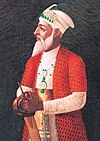 |
Nizam-ul-Mulk, Asaf Jah I نظامالملک آصف جاہ |
Mir Qamar-ud-din Khan |
20 August 1671 | 31 July 1724 | 1 June 1748 | |
 |
Nasir Jung نصیرجنگ |
Mir Ahmed Ali Khan | 26 February 1712 | 1 June 1748 | 16 December 1750 | |
 |
Muzaffar Jung مظفرجنگ |
Mir Hidayat Muhi-ud-din Sa'adullah Khan | ? | 16 December 1750 | 13 February 1751 | |
 |
Salabat Jung صلابت جنگ |
Mir Sa'id Muhammad Khan | 24 November 1718 | 13 February 1751 | 8 July 1762 (deposed) |
16 September 1763 |
 |
Nizam-ul-Mulk, Asaf Jah II نظامالملک آصف جاہ دوم |
Mir Nizam Ali Khan | 7 March 1734 | 8 July 1762 | 6 August 1803 | |
 |
Sikander Jah, Asaf Jah III سکندر جاہ ،آصف جاہ سوئم |
Mir Akbar Ali Khan | 11 November 1768 | 6 August 1803 | 21 May 1829 | |
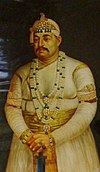 |
Nasir-ud-Daula, Asaf Jah IV ناصر الدولہ ،آصف جاہ چہارم |
Mir Farqunda Ali Khan | 25 April 1794 | 21 May 1829 | 16 May 1857 | |
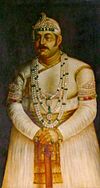 |
Afzal-ud-Daula, Asaf Jah V افضال الدولہ ،آصف جاہ پنجم |
Mir Tahniyath Ali Khan | 11 October 1827 | 16 May 1857 | 26 February 1869 | |
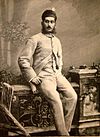 |
Asaf Jah VI آصف جاہ شیشم |
Mir Mahbub Ali Khan میر محبوب علی خان |
17 August 1866 | 26 February 1869 | 29 August 1911 | |
 |
Asaf Jah VII آصف جاہ ہفتم |
Mir Osman Ali Khan میر عثمان علی خان |
6 April 1886 | 29 August 1911 | 17 September 1948 (deposed) |
24 February 1967 |
Nasir Jung, Muzaffar Jung and Salabat Jung:- * These three rulers are not enumerated in the order of the Asaf Jah's, mainly because they were not granted the title of ASAF JAH by the Mughal Emperor.
See also[]
- Hyderabad State
- Nizam of Hyderabad
- National Anthem of Kingdom of Hyderabad
- Paigah
- Salar Jung family
- List of Sunni Muslim dynasties
References[]
- ^ Gurusamy, Mohan (18 October 2016). "Celebrating a long gone Hyderabad". The Deccan Chronicle. Retrieved 5 July 2021.
- ^ "Nizams". Archived from the original on 16 April 2007.
- ^ "SECUNDERABAD: ORIGINS, TALES & ARMY CONNECTION". February 2017.
- ^ "Mir Farkhunda Ali Khan Nasir-ud-daula - Asaf Jah IV of Hyderabad, India". Archived from the original on 7 December 2018. Retrieved 30 September 2018.
- ^ "Nasir-ud-Daula & Afzal-ud-daula | Telangana History: From Nizam's to Integration into Indian Union".
- ^ "NIZAM OF HYDERABAD DEAD.; Premier Prince of Indian Empire Had Annual Income of $10,000,000".
- ^ Chakraberty, Sumit (16 September 2012). "Staying at Falaknuma is like holding a mirror up to our past". DNA. Retrieved 22 October 2018.
- ^ "Letters leave a rich legacy of rulers".
- ^ "Picturing the 'Beloved'".
- ^ "Nizam VII cared more for people than himself". 26 May 2018.
- ^ "Nizam Hyderabad Mir Osman Ali Khan was a perfect secular ruler". 13 August 2015.
- ^ "Nizam gave funding for temples, and Hindu educational institutions". Archived from the original on 8 July 2018. Retrieved 30 September 2018.
- ^ "Osmania University first to teach in blend of Urdu & English - Times of India".
- ^ "Reminiscing the seventh Nizam's enormous contribution to education".
- ^ Mir Ayoob Ali Khan (19 February 2018). "Last surviving son of Nizam, Fazal Jah, dies". Archived from the original on 20 February 2018. Retrieved 18 December 2018.
- ^ "Last Surviving son of seventh Nizam passes away in Hyderabad". Archived from the original on 18 December 2018. Retrieved 18 December 2018.
- ^ "Nizam's heirs seek Pakistani intervention to unfreeze bank account". indiatoday. 20 July 2012. Archived from the original on 18 December 2018. Retrieved 18 December 2018.
- ^ Mohla, Anika. "From richest to rags in seven generations". The New Indian Express. Archived from the original on 14 August 2015. Retrieved 18 August 2015.
- ^ "India finally settles £1million Nizam dispute". Archived from the original on 11 April 2019. Retrieved 11 April 2019.
- ^ "A prince's ransom | the Guardian | guardian.co.uk". Archived from the original on 9 February 2018. Retrieved 11 April 2019.
External links[]
- 1724 establishments in India
- 1948 disestablishments in India
- Asaf Jahi dynasty
- Dynasties of India
- History of Telangana
- Hyderabad State people
- Nawabs of India
- Royal titles
- Titles in India
- Titles of national or ethnic leadership